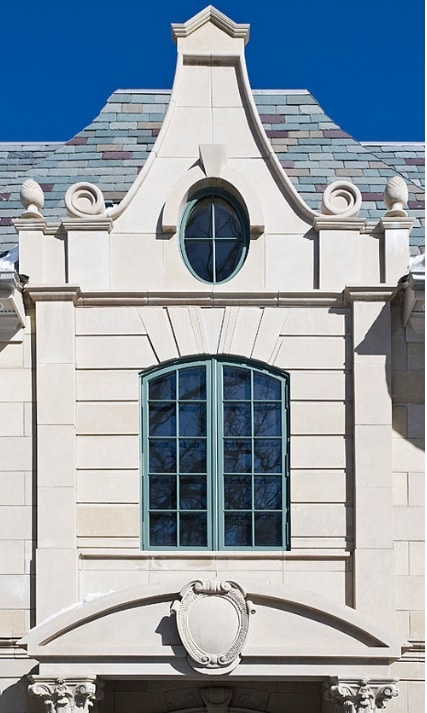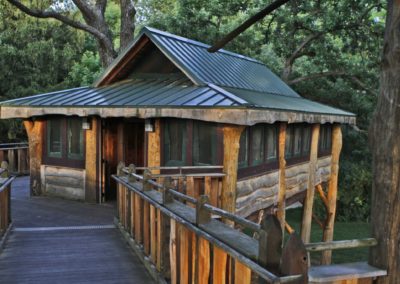“Study nature, love nature, stay close to nature. It will never fail you.” -Frank Lloyd Wright

Pictured above: Custom-cut Limestone Façade
That’s a simple yet powerful quote that sets the tone for my blog post today. If you’ve been reading some of my recent blogs, you know that I build and remodel homes to last. Building for longevity is a running theme with me. In fact, it’s one of the tenets I live by and how I run my residential design/build firm. It should be no surprise then that I love talking about the timeless beauty and durability of natural stone. If you’re building a new custom home or planning to remodel, consider natural stone for Glencoe IL homes or anywhere on the North Shore and greater Chicagoland area. Truthfully, I can write dozens of blogs on the topic of natural stone, but for now, I’m going to focus on the home’s exterior. This is going to be a general introduction about stonework and masonry. Hopefully you’ll come away with a few points to add to your design file, and launch a discussion with me when you are ready to build or remodel.
History of Natural Stone
I can boil down a few basics without giving a full geology lesson here. Stone comes from the earth. It’s a natural solid formation of one or more minerals. These minerals came from the same liquid and gas minerals that actually formed the earth. Over time, the minerals cooled and condensed to a solid core, then were pushed up to the earth’s surface, forming rock beds. Today, these beds are used as quarries where the stone is mined.

Pictured above: The front of the Barnenez Cairn in Brittany, France
Stone is the singular element that is found in the most ancient structures across the world that are still standing today. The oldest monument in the world is the Cairn of Barnenez in the westernmost region of France, which dates back to about 4,800 B.C.(predatingEgypt’s pyramids).My point here is that there’s no other product on this earth that could make the longevity claim that stone can make.
When did builders start using natural stone?
I answered this question, in part, earlier. Stonemasonry is one of the mankind’s oldest crafts. It’s the art of obtaining rough pieces of stone or rock (quarrying) and fixing it (sawing, shaping, sculpting) so it can be used to build homes and other structures. The New Stone Age (10,200 B.C. – 2,000 B.C. … a long timeframe) is when civilization learned how to use fire to create quicklime, plasters and mortars. They used these materials to build homes with mud and straw, then eventually transitioned to using stone for the structures. Stonemasonry refers to the construction of stones bonded together with mortar.
Then during the medieval period — from the 5th to the 15th century — (think: churches and castles!), the trade was in high demand and the stonemasons guild was established. Fast forward to the 20th Century: with the inventions of modern machinery (internal combustion engine, cranes, forklifts, motor-powered mortar mixers, compressed-air-powered tools, technologically advanced, electric-powered saws and chisels to name a few), stonemasons have perfected their craft and were able to achieve a level of precision their predecessors would be amazed at.
So where do these professional tradesmen, still known as stonemasons, work today? Read on …
Where can you find natural stone locally?
Stone quarries are located all over the world. We’re in the land of plenty – the United States – and we have some large quarries located right here in the Midwest, including:
- The Thornton Quarry in Thornton, IL, just south of Chicago
- The McCook Quarry in McCook, IL, a “stone’s throw away” from Chicago’s Interstate 55 (I couldn’t resist the pun)
- The Halquist Stone Quarry Areas near Sussex, WI, which is about 19 miles northwest of Milwaukee (Halquist Stone quarries in Lannon, Chilton, Fond du Lac and Stevens Point, WI).
Types of natural stone used for home building
Because the type of stone found in the ground is different based on the part of the country you are in, the typical stone used on homes in each area usually reflects the stone found at the local quarries. Here in Illinois and Wisconsin, the quarries produce more limestone so that is why you see limestone as the primary stone on our homes. On the East Coast, you will see more granite. Below are the stones found across the country; I’ll address local pricing as I wrap up this blog post below.
Granite: Granite is often used on exteriors because it is the hardest of all structural stones. It is incredibly strong, dense, and resilient — and is virtually maintenance-free. Its beauty is stunning, too (you can see glistening, colorful mineral-rich crystals and natural patterns, so it has ornamental value as well). Typically, darker colors are more common in granite. Granite is only slightly porous and will stain if not treated properly.
Marble: Marble’s texture, appearance and contrast of heavy veining and base color is extraordinary. It has a timeless style and rich palette of beautiful colors. Homeowners love its high-gloss. There’s truly nothing like it on earth. Marble may be carved or sculpted in many ways, making it one of the most versatile decorative stones. It is not as durable as granite. It’s a porous stone, and is easily scratched.

Pictured above: Project featuring natural limestone and stucco
Limestone: Limestone is known for its natural, earthen appearance with its smooth, granular surface. It does not show much graining at all, and has little color variation from tile to tile (mainly muted, soft tones of beige and tan, though also natural in black, grey, white, yellow and brown).It varies in hardness and can be used for shaping different moldings like window surrounds. The stone can be sanded perfectly smooth for a soothing, refined look, or machine-tumbled for a worn look. Dense limestone can be polished or honed. Limestone is slightly porous and may need to be re-sealed. It is more likely to stain than marble.

Pictured above: The Empire State Building in NYC
Indiana Limestone: Indiana limestone is primarily quarried in south-central Indiana. Indiana limestone typically has very uniform texture and grade. It is smooth and much softer than other types of natural stone, so it can be cut and carved more easily, in an almost limitless variety of shapes and sizes. Indiana Limestone exhibits three colors: gray, buff and variegated, which includes patterns of both gray and buff. The Empire State Building in New York City is clad in Indiana Limestone!
Travertine: Part of the limestone family, travertine is often mistaken for marble. It is highly durable but is also more susceptible to staining than granite or marble. Its color choices are more limited to beige, cream, reddish or neutral colors, and often have a distressed appearance. Its patterns and veining effects were formed by hot spring water percolating through underground limestone.
Slate: If rustic-classic is the look you’re after, slate is for you. Durable and stain-resistant, slate products are often used for flooring, cladding and landscaping. Formed over thousands of years of sedimentary deposit and compression, slate splits naturally into beautifully textured layers. You can find various shades of slate colors often within the same piece of stone. The most common slate color families are: black, brown, dark grey, red or green. One drawback is that it is a very thin stone and can break if not installed correctly or if used in the wrong area.
Quartz/Quartzite: Quartz is a rock similar to slate with a medium-grained texture. It is hard, dense and extremely abrasion- and chemical-resistant. Quartz shimmers and sparkles in a remarkable range of colors and patterns. Quartzite is widely used for wall veneers and decorative tiles. Having a naturally non-skid texture makes it a perfect candidate for flooring indoors and out, including areas with heavy traffic and exposure to the elements.
Read about the difference between quartz and quartzite here and here.
Sandstone: Sandstone has great weather-resistant durability. It has a softer, uniform texture and beautiful appearance. It can be found in a variety of colors and finishes, the most common being in the light brown and red color families. Sandstone is susceptible to staining and needs regular maintenance. It is popular for exterior walls, floors and pavers.

Pictured above: A project featuring stone from Architectural Stone LLC
Soapstone: Because of its high talc content, soapstone is a relatively soft stone. As talc in soapstone is soft to the touch, it gives the smooth feeling of rubbing a piece of dry soap, which is how its name was derived. It is a dense mineral that wears well and is often resistant to stains. A weathered or aged appearance will occur naturally over time as the patina is enhanced. Popular applications for soapstone includebalusters, stair treads and window sills.
Where is natural stone used in the home today?
Because of its versatility, homeowners can use natural stone in creative ways throughout their home:

Pictured above: Door surround using limestone
Exterior: facades, walls, accents, door surrounds, hardscapes and entries, railings, columns, posts, walkways, pavers, patios, fireplaces, outdoor kitchens (countertops and range hoods), steps and waterfalls/fountains, driveways, pools, retaining walls and stepping stones.
Interior: floors, kitchen and bath countertops, backsplashes, islands, walls, bathtubs, showers, sinks, hallways, fireplaces, hearths, mantles, desktops, vanities, decorative hood surrounds and entryways.

Pictured above: Interior project using Halquist Stone
Why do people choose natural stone for Glencoe IL homes? The five main reasons my clients, design collaborators and I choose natural stone are:
- Durability: Stone has a track record of standing for thousands of years. Its ability to withstand elements is unmatched by anything else. It does NOT fail.
- Timeless Beauty: Those minerals that I mentioned earlier that are naturally found in the earth – that formed the earth – consist of a vast spectrum of colors and patterns that cannot be replicated by engineering. Just looking at stunning, hand-crafted stone leaves a lasting impression on people.
- Design Flexibility/Versatility: There are limitless design options for clients when it comes to natural stone. If you can imagine it, it can be done.
- Character/Uniqueness: Stone adds character for any new construction or remodeling project. Use stone as an accent if you are remodeling your home that already includes brick.
- Green Building: Stone is a natural product with enduring life. It is linked to improved indoor air quality and also contributes to energy efficiency. In addition, environmentally responsible companies like Halquist Stone practice quarry reclamation.

Pictured above: A project featuring stone from Halquist Stone
The Stonemasonry Profession – Installation of natural stone must be done properly or the home will eventually have problems.
Another running theme for me and my company is the Diamond Difference: dedication, details, depth and delivery. This is our brand, and I expect this from everyone we work with. Professionalism and top quality in all things is a must – it’s what I demand from my team.
I can’t emphasize enough the importance of having a well-schooled stonemason who has had proper training work on your project! You can purchase the world’s most magnificent stone products for your home, but if you don’t work with properly trained stonemasons, you can invite unwanted aesthetic, moisture and water issues. Everything comes down to HOW the stones are installed!

Pictured above: Project featuring stone veneer from Architectural Stone LLC
From understanding, respecting and knowing how to handle the natural elements of stone to constantly perfecting their detailed techniques, stonemasons need to undergo an extensive amount of training in order to be qualified to install natural stone properly. If your home’s installation lacks the proper details, the work on it may only last 10-15 years! This is an abomination, yet I’ve seen this scenario play out hundreds of times as I’m called in to remodel facades of newer homes due to an improper installation performed by the original builder.
The level of complexity from project to project varies. The freezing temperatures can also play a critical role. All water-based mortars can’t be exposed to freezing temperatures during the curing process. Stones don’t typically fail. What usually fails is the mortar that is used to set the stone and the method used during the installation.
During the building boom in the early 2000s, many uninformed architects and builders tried to take shortcuts by neglecting to design and install a masonry wall based on what we have learned over at least the last 1,000 years. A masonry wall takes in moisture and needs to have a design that allows air movement and flashing systems to divert the moisture and allow the wall to dry so this moisture does not wick into the wall cavity. Specifically, there are hundreds of buildings built in the Chicago area trying to use a single cinderblock wall with a painted finish. As this paint was exposed to the elements, it broke down and allowed the moisture and water to soak up into the cinderblock wall and the insulation behind it like a sponge.
We actually performed a major repair on a home where there were hundreds of gallons of water in the wall system that required that we remove drywall, remove insulation and go through a drying process taking months requiring at least two commercial dehumidifiers running 24-hours a day. We also had to go to the root of the problem and install a stucco over the cinderblock wall to create a wall system that would not retain moisture. This same scenario played out in hundreds of Chicagoland homes costing the owners millions of dollars in repairs.
William Decker is a home inspector in Glencoe, IL. He wrote a great, succinct blog explaining this pervasive problem.
Another cautionary note: Your home’s exterior must have proper flashing details. Again, water will get in and the flashings need to divert it out again. If it doesn’t get diverted out, it will show up as leaks around your windows. Problems like the ones I’ve mentioned are actually easy to avoid, but sub-par stonemasons who aren’t trained properly will increase your chances of damage. You will never outsmart water with faulty construction techniques.
The message to take away here is that experience and quality standards matter. You have to hire a GC who understands all of this to ensure your project is built right and built with longevity in mind! In most parts of the world, people think of building in terms of thousands of years. Here in the United States, we think of them in terms of 50-80 years. This is misguided thought!Any well-built home in America should stand for hundreds of years if it was built right and is maintained properly. You only get one chance to do it right.
*Pricing of Natural Stone
Pricing depends on your location, design and materials used. Here is some general cost information for the Glencoe (North Shore) area, Cook and DuPage counties using some of the more common brick and stone and cement-based materials:
- Brick Veneer: Average Price range $11.00-$13.00 PSF
- Traditional Hard Coat Stucco: Average Price range $10.00-$13.00 PSF
- Limestone and Sandstone: Average Price Range $25.00-$30.00 PSF
- Indiana Limestone installed as a Veneer $40.00-$50.00 PSF
*Note that these ranges are for labor and materials but exclude decorative window and door surrounds, drainage mats, etc.
Natural Stone maintenance
You must understand how to take care of the stones you’ve installed in your home since some may have adverse reactions to certain cleaning chemicals and procedures.
Building for Longevity
“Nature never hurries. Atom by atom, little by little, she achieves her work.” –Ralph Waldo Emerson
When you’re building with the right design/build team, consider using natural stone. You can expect a longevity of hundreds of years with proper installation and maintenance so generations of your family can enjoy the home. Call me anytime with more questions.




